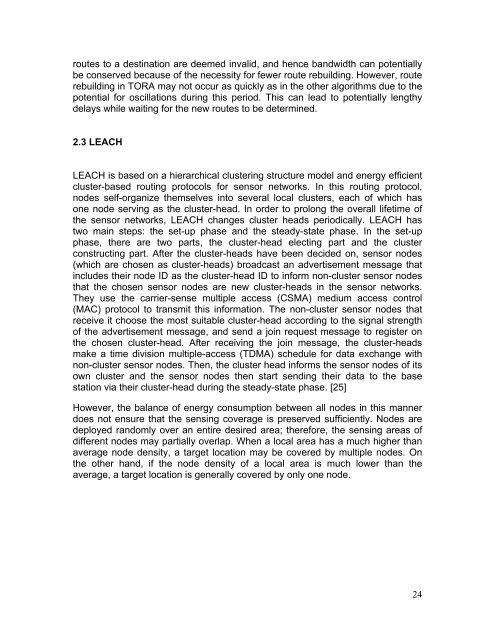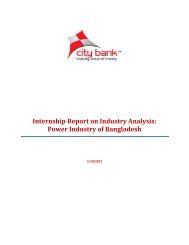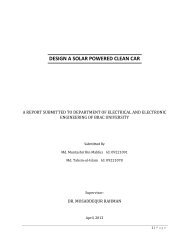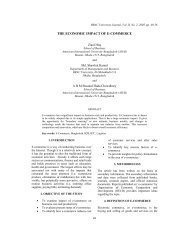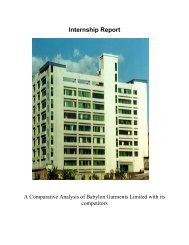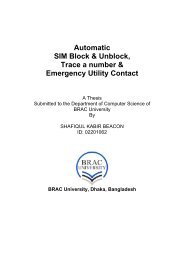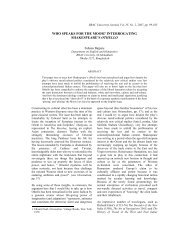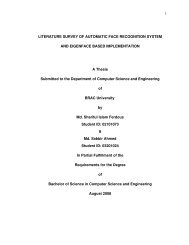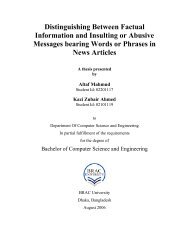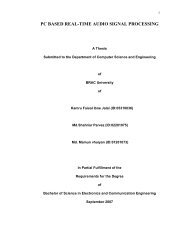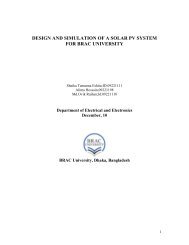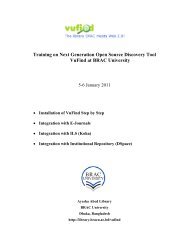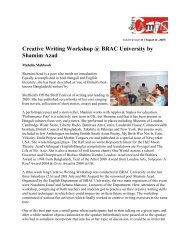Routing protocols in wireless sensor networks
Routing protocols in wireless sensor networks
Routing protocols in wireless sensor networks
You also want an ePaper? Increase the reach of your titles
YUMPU automatically turns print PDFs into web optimized ePapers that Google loves.
outes to a dest<strong>in</strong>ation are deemed <strong>in</strong>valid, and hence bandwidth can potentially<br />
be conserved because of the necessity for fewer route rebuild<strong>in</strong>g. However, route<br />
rebuild<strong>in</strong>g <strong>in</strong> TORA may not occur as quickly as <strong>in</strong> the other algorithms due to the<br />
potential for oscillations dur<strong>in</strong>g this period. This can lead to potentially lengthy<br />
delays while wait<strong>in</strong>g for the new routes to be determ<strong>in</strong>ed.<br />
2.3 LEACH<br />
LEACH is based on a hierarchical cluster<strong>in</strong>g structure model and energy efficient<br />
cluster-based rout<strong>in</strong>g <strong>protocols</strong> for <strong>sensor</strong> <strong>networks</strong>. In this rout<strong>in</strong>g protocol,<br />
nodes self-organize themselves <strong>in</strong>to several local clusters, each of which has<br />
one node serv<strong>in</strong>g as the cluster-head. In order to prolong the overall lifetime of<br />
the <strong>sensor</strong> <strong>networks</strong>, LEACH changes cluster heads periodically. LEACH has<br />
two ma<strong>in</strong> steps: the set-up phase and the steady-state phase. In the set-up<br />
phase, there are two parts, the cluster-head elect<strong>in</strong>g part and the cluster<br />
construct<strong>in</strong>g part. After the cluster-heads have been decided on, <strong>sensor</strong> nodes<br />
(which are chosen as cluster-heads) broadcast an advertisement message that<br />
<strong>in</strong>cludes their node ID as the cluster-head ID to <strong>in</strong>form non-cluster <strong>sensor</strong> nodes<br />
that the chosen <strong>sensor</strong> nodes are new cluster-heads <strong>in</strong> the <strong>sensor</strong> <strong>networks</strong>.<br />
They use the carrier-sense multiple access (CSMA) medium access control<br />
(MAC) protocol to transmit this <strong>in</strong>formation. The non-cluster <strong>sensor</strong> nodes that<br />
receive it choose the most suitable cluster-head accord<strong>in</strong>g to the signal strength<br />
of the advertisement message, and send a jo<strong>in</strong> request message to register on<br />
the chosen cluster-head. After receiv<strong>in</strong>g the jo<strong>in</strong> message, the cluster-heads<br />
make a time division multiple-access (TDMA) schedule for data exchange with<br />
non-cluster <strong>sensor</strong> nodes. Then, the cluster head <strong>in</strong>forms the <strong>sensor</strong> nodes of its<br />
own cluster and the <strong>sensor</strong> nodes then start send<strong>in</strong>g their data to the base<br />
station via their cluster-head dur<strong>in</strong>g the steady-state phase. [25]<br />
However, the balance of energy consumption between all nodes <strong>in</strong> this manner<br />
does not ensure that the sens<strong>in</strong>g coverage is preserved sufficiently. Nodes are<br />
deployed randomly over an entire desired area; therefore, the sens<strong>in</strong>g areas of<br />
different nodes may partially overlap. When a local area has a much higher than<br />
average node density, a target location may be covered by multiple nodes. On<br />
the other hand, if the node density of a local area is much lower than the<br />
average, a target location is generally covered by only one node.<br />
24


